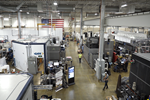3D Printing Rotors for Electric Motors (Video)
Oak Ridge National Laboratory describes research into applying additive manufacturing to replace windings in DC motors.
Can we 3D print an electric motor? Maybe yes for one vital component of it: the rotor — and that possibility holds important promise for better motor performance. Amiee Jackson is a researcher with Oak Ridge National Laboratory’s Manufacturing Demonstration Facility, and in this video, she discusses her work in producing rotors via laser powder bed fusion. Rotors are usually made by winding a conductive alloy. Changing the alloy composition to improve motor performance impedes manufacturing, because that change reduces the ductility that is important for winding. By offering a way to print the rotor with no winding involved, additive manufacturing potentially solves this problem.
Related resources:
- Oak Ridge National Laboratory’s Manufacturing Demonstration Facility
- AM technology from Renishaw
- More on laser powder bed fusion
- Additive manufacturing for another motor component: magnets
Related Content
-
What is Powder Bed Fusion 3D Printing?
Whether in metal or polymer, with a laser or an electron beam, powder bed fusion (PBF) is one of the most widely used 3D printing techniques.
-
AM 101: What is Ultrasonic Additive Manufacturing?
Going from additive to subtractive can be simple with Ultrasonic Additive Manufacturing (UAM). What is it and how does it work? Learn the basics in this 101 post.
-
World’s Largest Metal 3D Printer Seen at Ingersoll Grand Opening Event
Maker of large additive and subtractive machines adds capacity in Rockford, Illinois.












